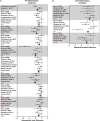A Systematic Meta-analysis of Immune Signatures in Patients With Acute Chikungunya Virus Infection
- PMID: 25635123
- PMCID: PMC4442625
- DOI: 10.1093/infdis/jiv049
A Systematic Meta-analysis of Immune Signatures in Patients With Acute Chikungunya Virus Infection
Abstract
Background: Individuals infected with chikungunya virus (CHIKV) normally exhibit a variety of clinical manifestations during the acute phase of infection. However, studies in different patient cohorts have revealed that disease manifestations vary in frequency.
Methods: Disease profiles between patients with acute CHIKV-infection and febrile patients without CHIKV were compared and examined to determine whether any clinical presentations were associated with the clinical outcome of CHIKV infection. Circulatory immune mediators profiles were then characterized and compared with data from 14 independent patient cohort studies. The particular immune mediator signature that defines acute CHIKV infection was determined.
Results: Our findings revealed a specific pattern of clinical presentations of joint-specific arthralgia from this CHIKV cohort. More importantly, we identified an immune mediator signature dominated by proinflammatory cytokines, which include interferon α and γ and interleukin 2, 2R, 6, 7, 12, 15, 17, and 18, across different patient cohorts of CHIKV load associated with arthralgia.
Conclusions: To our knowledge, this is the first study that associated levels of CHIKV load with arthralgia as an indicator of acute CHIKV infection. Importantly, our findings also revealed specific immune mediator signatures that can be used to better define CHIKV infection.
Keywords: acute infection; chemokines; chikungunya virus; cytokines; meta-analysis.
© The Author 2015. Published by Oxford University Press on behalf of the Infectious Diseases Society of America.
Figures







References
-
- Her Z, Kam YW, Lin RT, Ng LF. Chikungunya: a bending reality. Microbes Infect 2009; 11:1165–76. - PubMed
-
- Powers AM, Logue CH. Changing patterns of chikungunya virus: re-emergence of a zoonotic arbovirus. J Gen Virol 2007; 88:2363–77. - PubMed
-
- Ng LC, Hapuarachchi HC. Tracing the path of chikungunya virus—evolution and adaptation. Infect Genet Evol 2010; 10:876–85. - PubMed
-
- Enserink M. Infectious diseases: crippling virus set to conquer Western Hemisphere. Science 2014; 344:678–9. - PubMed
Publication types
MeSH terms
Substances
LinkOut - more resources
Full Text Sources
Other Literature Sources
Medical

